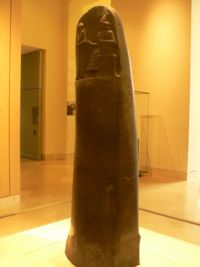Hammurabi
- For the microcomputer game, see Hamurabi.
Hammurabi, also often transliterated Hammurapi, was the sixth king of the first dynasty of Babylon. Under his rule, Babylonian hegemony was dramatically extended to control most of both southern and northern Mesopotamia. His reign lasted from 1792 BC until his death in 1750 BC (according to the middle chronology).
Early reign
When Hammurabi came to power following the death of his father Sin-Muballit, Babylon was a minor territorial power in northern Mesopotamia. The kingdom of Larsa under Rim-Sin controlled southern Mesopotamia, while much of northern Mesopotamia was under the rule of Shamshi-Addad of Assur.
Hammurabi's early year names suggest a domestic focus. For instance, Hammurapi year three is:
- The year he made the throne of the high dais [for] Nanna of Babylon, the Ekishnungal.
Other names similarly refer to religious construction (e.g. Ha 6) or large public works projects (e.g. Ha 8 and 9).[1]. Some year names do indicated military activity (e.g. Ha 7, The year Hammurabi, the king, captured Uruk (and) Isin). However, it seems that these referred to actions taken not by an independent Babylon, but rather as part of a coalition of states led by the more powerful states of Assur and Larsa.
Babylonian expansion
By his 30th year, Hammurabi initiated an aggressive series of military campaigns against rivals to the east and south. His defeat of Rim-Sin gave him control of all of southern Sumer, including the important religious center of Nippur. Within several years, Hammurabi added the important city of Eshnunna to the Babylonian state. Hammurabi's last main rival, Mari, fell to Babylon in his 35th year:
- The year Hammurabi, the king, at the command of An and Enlil, destroyed the walls of Mari and Malgium
With the destruction of Mari, Hammurabi had access to important trade routes along the western Euphrates.
Hammurabi's successors
XX
Babylon under Hammurabi
XX
The Code of Hammurabi
He is perhaps best known for promulgating his code of laws, known as the Code of Hammurabi.
References
- Van De Mieroop, Marc. A History of the Ancient Near East. Blackwell Publishing: Malden, 2005. ISBN 0-631-22552-8
- Babylonian Law. Britannica, 1911.
See also
External links
